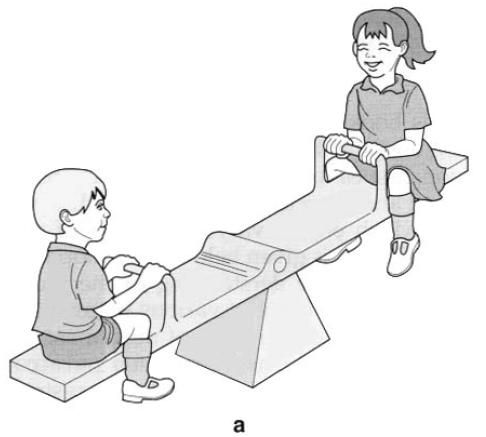A lever may be considered to be a simple, rigid
bar, with no account taken of its shape or structure. Most long bones appear as
rigid bars but although many bones, such as those of the skull, are far from
the usual concept of a lever they can, nevertheless, still act in this way.
The fulcrum is the point around which the lever
rotates. That part of the lever between the fulcrum and point of force
application is known as the force arm,
and that between the fulcrum and the point of load application is known as the load arm. This concept is easy to
understand when applied to a child’s see-saw(see picture below). Different
arrangements of the fulcrum, load and force arms produce different classes of
lever. There are three possible arrangements; a first class lever has the fulcrum between the load and force arms;
a second class lever has the fulcrum
at one end and the applied force at the other, with the load situated between
them; a third class lever again has
the fulcrum at one end but the load at the other with the applied force
between(see picture below).
All three classes of lever are found with the
human body; the fulcra are usually situated at the joints; the load may be body
weight or some external resistance, with the force usually being produced by
muscular effort. It is the complex arrangement of all three classes of lever
within the human body that produces movement.
A first
class lever is used in balancing weight and/or changing the direction of
pull. There is usually no gain in mechanical advantage, e.g. when standing on
the right lower limb the fulcrum is the right hip joint, the load being body
weight to the left of the hip, while the force is provided by the concentration
of the right gluteus medius and minimus muscles.
A second
class lever(the principle on which weight is lifted in a wheelbarrow),
gains mechanical advantage thereby allowing large loads to be moved, but with a
loss of speed. Raising up onto the toes is a good example of such a system; the
metatarsal heads act as the fulcrum, the weight of the body acting down through
the tibia is the load while the calf muscles contract to produce the required
force. The load arm is thus the distance from the tibia to the metatarsal
heads, while the force arm is the distance between the attachment of the calf
muscles to the calcaneus and the metatarsal heads.
A third
class lever is the most commonly found within the body. It works at a
mechanical disadvantage moving less weight but often at great speed. The biceps
brachii acting across the elbow is a good example of this class of lever.
The elbow is the fulcrum, the weight is the
forearm and hand being supported, with the force being provided by biceps. In
this example the load arm is the distance between the elbow and centre of mass
of the forearm and hand, whereas the force arm is the distance between the
elbow joint and the attachment of the biceps.
All movements of the human body are dependent
on the interaction of these three classes of lever. It is as well to remember
when studying the structure of the human body the relationship between the
joints, the attachment of relevant muscles and the load to be moved. This will
lead to an understanding of functional anatomy and with it human movement.











0 коментара:
Постави коментар